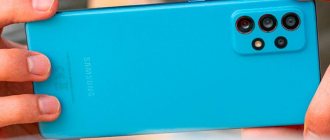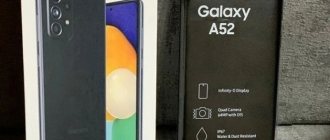When the first news arrived about the revival of the seemingly buried Pocophone brand, it never even occurred to me that Xiaomi would go so far in this matter. Now this is not just an option to get the most powerful smartphone for the least amount of money (as was the case with the first iteration - the flagship hardware platform was installed in a middle-class smartphone based on other characteristics), but already a full-fledged sub-brand with its own model range.
The word “pocophone”, however, became a thing of the past along with the first attempt to launch a brand - it was replaced by the laconic POCO. We have already dealt with two POCOs this year: POCO F2 Pro more or less continues the work of its ancestor from 2018, but does not lay claim to price records; POCO X3 NFC first took an incomprehensible position, but then sharply fell in price and logically topped our a selection of the best smartphones under 20 thousand rubles. The new POCO M3 could also be included in this selection, but adjusted for a more budget-friendly focus. This smartphone is designed to hit the jackpot in the “about 10 thousand rubles” segment: it has a fresh Qualcomm Snapdragon 662 platform, an unexpected design, a giant battery (6000 mAh), stereo speakers and a 48-megapixel camera. Yes, no compromises anywhere (after all, we are talking about a gadget that costs about 14 thousand): no NFC, no wide-angle module, no fast charging. But the list of attractive features is very tempting - is it worth giving in to this trick?
⇡#Technical characteristics
| Xiaomi POCO M3 | Xiaomi Redmi Note 9S | motorcycle G8 | Infinix Zero 8 | Honor 10X Lite | |
| Display | 6.53 inches, IPS, 2340 × 1080 pixels, 395 ppi; capacitive, multi-touch | 6.67 inches, IPS, 2400 × 1080 pixels, 395 ppi; capacitive, multi-touch | 6.4 inches, IPS, 1560 × 720 pixels, 268 ppi; capacitive, multi-touch | 6.85 inches, IPS, 2460 × 1080 pixels, 392 ppi; capacitive, multi-touch | 6.67 inches, IPS, 2400 × 1080 pixels, 395 ppi, capacitive multi-touch |
| Protective glass | Corning Gorilla Glass 3 | Corning Gorilla Glass 5 | No information | No information | No information |
| CPU | Qualcomm Snapdragon 662: quad Kryo 260 Gold cores, 2.0 GHz + quad Kryo 260 Silver cores, 1.8 GHz | Qualcomm Snapdragon 720G: eight cores (2 × Kryo 465 Gold, 2.3 GHz and 6 × Kryo 465 Silver, 1.8 GHz) | Qualcomm Snapdragon 665: four Kryo 260 Gold cores, 2.0 GHz + four Kryo 260 Silver cores, 1.8 GHz | Mediatek MT6785 Helio G90T: eight cores (2 × Cortex-A76, 2.05 GHz + 6 × Cortex-A55, 2.0 GHz) | HiSilicon Kirin 710A: eight cores (4 × ARM Cortex A73, 2.0 GHz + 4 × ARM Cortex A53, 1.7 GHz) |
| Graphics controller | Adreno 610 | Adreno 618 | Adreno 610 | ARM Mali-G76 MC4 | ARM Mali-G51 MP4 |
| RAM | 4 GB | 4/6 GB | 4 GB | 8 GB | 4 GB |
| Flash memory | 64/128 GB | 64/128 GB | 64 GB | 128 GB | 128 GB |
| Connectors | USB Type-C, 3.5 mm mini-jack | USB Type-C, 3.5 mm mini-jack | USB Type-C, 3.5 mm | USB Type-C, 3.5 mm mini-jack | USB Type-C, 3.5 mm mini-jack |
| Memory card slot | Yes (separate slot for microSD) | Yes (separate slot for microSD) | Yes (hybrid slot for microSD/second nano-SIM) | Yes (separate slot for microSD) | Yes (separate slot for microSD) |
| SIM cards | 2 × nano-SIM | 2 × nano-SIM | 2 × nano-SIM | 2 × nano-SIM | 2 × nano-SIM |
| Cellular connection 2G | GSM/GPRS/EDGE 850/900/1800/1900 MHz | GSM/GPRS/EDGE 850/900/1800/1900 MHz | GSM/GPRS/EDGE 850/900/1800/1900 MHz | GSM/GPRS/EDGE 850/900/1800/1900 MHz | GSM/GPRS/EDGE 900/1800/1900 MHz |
| Cellular 3G | HSDPA 850/900/1700/1900/2100 MHz | HSDPA 850/900/1700/1900/2100 MHz | HSDPA 850/900/1700/1900/2100 MHz | HSDPA 850/900/2100 MHz | HSDPA 850/900/1900/2100 MHz |
| Cellular 4G | LTE, bands 1, 2, 3, 4, 5, 7, 8, 20, 28, 38, 40, 41 | LTE, bands 1, 3, 4, 5, 7, 8, 20, 28, 38, 40 | LTE, bands 1, 2, 3, 4, 5, 7, 8, 20, 38, 40, 41 | LTE Cat.4 (Cat4 150/50 Mbps): 1, 3, 5, 7, 8, 20, 28, 38, 40, 41 | LTE: 1, 2, 3, 4, 5, 7, 8, 20, 28, 38, 40, 41 |
| WiFi | 802.11a/b/g/n/ac; 2.4/5 GHz | 802.11a/b/g/n/ac; 2.4/5 GHz | 802.11 b/g/n; 2.4 GHz | 802.11 a/b/g/n; 2.4/5 GHz | 802.11a/b/g/n/ac; 2.4/5 GHz |
| Bluetooth | 5.0 | 5.0 | 5.0 | 5.0 | 5.1 |
| NFC | No | No | Eat | No | Eat |
| Navigation | GPS, A-GPS, GLONASS, BeiDou | GPS, A-GPS, GLONASS, BeiDou, Galileo | GPS, A-GPS, GLONASS, Galileo, BeiDou | GPS, A-GPS; other supported systems are not specified | GPS, A-GPS, GLONASS, BeiDou |
| Sensors | Illumination, proximity, accelerometer/gyroscope, magnetometer (digital compass) | Illumination, proximity, accelerometer/gyroscope, magnetometer (digital compass) | Illuminance, proximity, accelerometer/gyroscope | Illumination, proximity, accelerometer/gyroscope, magnetometer (digital compass) | Illuminance, proximity, accelerometer/gyroscope |
| Fingerprint's scanner | Yes (on the side key) | Yes (on the side key) | Yes (on the rear panel) | Yes, on the side button | Yes, on the side button |
| Main camera | Triple module: 48 + 2 + 2 MP, ƒ/1.8 + ƒ/2.4 + ƒ/2.4, phase detection autofocus, single LED flash | Quadruple module: 48 + 8 + 5 + 2 MP, ƒ/1.8 + ƒ/2.2 + ƒ/2.4 + ƒ/2.4, phase detection autofocus, single LED flash | Triple module: 16 MP, ƒ/1.7 + 8 MP, ƒ/2.2 + 2 MP, ƒ/2.2 (macro camera), hybrid autofocus, LED flash | Quadruple module: 64 MP, ƒ/1.9 + 8 MP, ƒ/2.3 + 2 MP, ƒ/2.4 + 2 MP, ƒ/2.4, phase detection autofocus, quad LED flash | Triple module: 48 + 8 + 2 MP, ƒ/1.8 + ƒ/2.4 + ƒ/2.4, phase detection autofocus, LED flash |
| Front-camera | 8 MP, ƒ/2.1, no autofocus, no flash | 16 MP, ƒ/2.5, without autofocus, with flash | 8 MP, ƒ/2.0, no autofocus, no flash | Dual module: 48 + 8 MP, ƒ/2.2 + ƒ/2.2, no autofocus, no flash | 8 MP, ƒ/2.0, no autofocus, no flash |
| Nutrition | Non-removable battery: 22.8 Wh (6000 mAh, 3.8 V) | Non-removable battery: 19.08 Wh (5020 mAh, 3.8 V) | Non-removable battery: 15.2 Wh (4000 mAh, 3.8 V) | Non-removable battery: 17.1 Wh (4500 mAh, 3.8 V) | Non-removable battery: 19 Wh (5000 mAh, 3.8 V) |
| Size | 162.3 × 77.3 × 9.6 mm | 165.8 × 76.7 × 8.8 mm | 161.3 × 75.8 × 9 mm | 168.7 × 76.1 × 9.1 mm | 165.7 × 76.9 × 9.3 mm |
| Weight | 198 grams | 209 grams | 188 grams | 205 grams | 206 grams |
| Water and dust protection | No | Splash protection | P2i (splash protection) | No | No |
| operating system | Android 10, MIUI 12 shell | Android 10, MIUI 11 shell | Android 10 | Android 10, XOS 7.0 shell | Android 10, Magic UI shell (without Google services) |
| Current price | 13,490 rubles for the 4/64 GB version, 14,490 rubles for the 4/128 GB version | 15,249 rubles for the 4/64 GB version, 17,500 rubles for the 6/128 GB version | 12,990 rubles | About 16 thousand rubles | 14,990 rubles |
| Xiaomi POCO M3 – information about the filling according to the CPU-Z application. Don’t pay attention to the signature in the SOC section - it’s just that the Snapdragon 662 and 665 platforms are as close as possible, and CPU-Z can’t distinguish them | ||||
Hardware performance
Poco M3 Pro 5G is powered by one of MediaTek's newest 5G processors, the Dimensity 700. It is an octa-core chipset with two cores clocked at 2.2 GHz and six cores clocked at 2.0 GHz.
There are two versions of the M3 Pro 5G, distinguished by the amount of RAM and internal memory – 4/64 GB and 6/128 GB.
The performance of the 7nm MediaTek Dimensity 700 is good, even in games. The processor is ideal for smartphones in the mid-price segment, although the graphics core is rather weak. However, the tested Poco copes easily even with complex and resource-intensive tasks.
The system based on the latest version of MIUI also works without problems, and for a smartphone, the performance is good.
⇡#Design, ergonomics and software
Experiments in smartphone design today are almost impossible - at the same time, the field for these very experiments is too narrow (the form factor obliges one to make certain decisions on appearance), and the power of trends is too great. Doing things “differently” is simply dangerous for sales. But Xiaomi did something unexpected.
From the front, the POCO M3 is a smartphone like a smartphone, even a little outdated with its waterdrop notch instead of a hole. The frames around the display are small (the screen ultimately occupies 83.4% of the front surface of the gadget), but this will not surprise anyone.
POCO M3, front panel: front camera in the cutout at the top, speaker under the top edge
But from behind, the new contender for leadership in the budget segment looks very unusual. The three-chamber module seems to be quite standard - the lenses are inscribed in a glossy rectangular panel in the corner of the body - but is visually combined with a glossy black panel with a large “POCO” inscription. In our age of major labels, the solution is both relevant and bold, only Honor 30 Pro+ comes to mind. Even more curious is the covering of the rest of the rear panel - made of rough plastic “leather-like”. Not only does it look fresh, but the smartphone also doesn’t slip in your hand at all, so you can safely discard the case.
POCO M3, rear panel: top left - triple camera unit and single LED flash
The POCO M3's body is large, as expected from a gadget with a 6.53-inch diagonal screen, but remains within the bounds of decency - 162.3 × 77.3 × 9.6 mm. Only the thickness differs slightly from the standards - and it is clear that this is due to the huge 6,000 mAh battery. The smartphone fits well into ordinary pockets, and although it is more of a “two-handed” gadget, it is quite comfortable to hold.
POCO M3, left side: slot for two SIM cards and one memory card
POCO M3, right side: lock/power key with integrated fingerprint scanner and volume key
POCO M3 comes in three colors: blue, yellow and black. Of course, the blue and yellow POCO look especially bright and fresh, but we got a black one for testing, which, thanks to its “leather-like” coating, gives the impression of a very solid gadget, obviously not for 14 thousand rubles.
POCO M3, top edge: speaker, IR port, mini-jack, microphone
POCO M3, bottom edge: microphone, USB Type-C port, speaker
Otherwise, this is a fairly standard budget smartphone for 2020: a mini-jack on the top edge, a USB Type-C port (yes, after all) on the bottom, a fingerprint scanner integrated into the side power/lock key.
The side scanner fulfills its duties quite successfully - yes, the coverage area is small, sometimes you have to touch it again for the smartphone to recognize the owner, but the problem with random unlocking in the pocket has been solved. Firstly, the capacitive sensor here is not hypersensitive in any case, and will not work accidentally again. Secondly, you can choose to unlock the gadget either by touching the surface of the key with the scanner or by pressing it fully, which will finally solve this issue. You can duplicate the scanner with a facial recognition system using the front camera - this system works quickly, but a lot of questions always arise about the reliability of this method.
Screenshot gallery
View all images (25)POCO M3 runs on Android 10 running MIUI 12 shell. The fact that this is not Mi or Redmi is only reminded by minor details like the ability to select dynamic lock screen wallpapers with links (like wallpapers for Windows) and some design elements that are not conspicuous. Poco Launcher, having given its main distinguishing features to the “big” Xiaomi shell (like subsections in the application menu), is gradually becoming a thing of the past. By the way, the camera icon, which was so puzzling with its similarity to the Chrome icon in POCO X3 NFC, was changed to the standard one from MIUI - now no problems. The shell works stably, but not very quickly - sometimes it takes up to three seconds to exit the locked state, and there are five-second pauses when launching basic but heavy applications (for example, a camera). Still, signs of budgeting are felt, albeit not very serious.
Xiaomi Poco M3 as a toy
Everything is expected. There are no games that you can't play. But in most cases the graphics settings will have to be lowered to medium. Otherwise it will be excruciatingly painful.
| A game | Problems? |
| Asphalt 8: Take Off | 30 fps with 100% stability on medium graphics (it is impossible to set the maximum) |
| Dead Trigger 2 | 60 fps (100%) on maximum graphics. |
| World of Tanks Blitz | 23 fps (87%) on maximum graphics, 60 fps (100%) on medium. |
| PUBG Mobile | 30 fps (100%) on Smooth/High graphics |
| World of Warships Blitz | 46 fps (98%) on maximum graphics. |
| Into the Dead 2 | 14 fps with 64% stability on maximum graphics. On the average graphics all 30 fps (94%), but small freezes still happen. |
| Shadowgun Legends | 19 fps (80%) on maximum graphics, 54 fps (96%) on medium graphics. |
PS Stability - what percentage of the time fps is within +-20% of the average.
FPS measurements in games have traditionally been done using a cool and serious tool called GameBench. Click on the link to find out more about it. (Thank you in advance for your click. These clicks are my payment for using this software. If there are no clicks, there will be no fps).
⇡#Display and sound
The main feature of POCO X3 NFC, in addition to the powerful hardware platform, was the screen with a refresh rate of 120 Hz, which made it possible to challenge the claims of realme 6 Pro to the title of the main mid-range smartphone in 2020. The POCO M3 also has a remarkable screen for its class - it does not have a high-frequency mode, but offers Full HD+ resolution, which is still rare for this price range. The panel is familiar, in particular, from last year’s Redmi Note 8 Pro: 6.53 inches, IPS, 2340 × 1080 pixels. Pixel density - 395 ppi.
The panel is not bad - the viewing angles are decent (although the brightness drops noticeably when the view is strongly deviated from the perpendicular), there is an oleophobic coating. Format - 19.5:9. Tempered Gorilla Glass 3 is used for protection.
But the measured maximum brightness level without software increase during auto-adjustment is 368 cd/m2 - the result is below average even in its class. You can use your smartphone in the sun (the anti-reflective coating is in place), but it’s not very comfortable. The contrast for an LCD panel is excellent - 1694:1.
The image settings are quite extensive: there is a special reading mode with a warm screen tone, font adjustments, dark mode, even special parameters for working with VR. Color rendering adjustment is also available: there is automatic adjustment depending on the lighting, a rich mode, a standard mode, and the ability to manually adjust the color tone to taste. I measured the color rendition of the display in saturated and standard modes.
POCO M3, gamma in rich mode. Yellow line – POCO M3 performance, dotted line – reference range
POCO M3, color temperature in rich mode. Blue line – POCO M3 indicators, dotted line – reference temperature
POCO M3, color gamut in rich mode. Gray triangle – sRGB coverage, white triangle – POCO M3 coverage
In both modes, the color gamut is close to the sRGB standard - the display is not friendly with an extended color gamut (and it also does not care about HDR). The gamma of shades of gray is standard (2.26) with a moderate spread of curves. The color temperature is increased, but not too significantly - it stays in the range from 7,000 to 8,000 K. The average deviation DeltaE on the Color Checker scale, which includes both a wide range of colors and shades of gray, is 4.01 with a norm of 3. 00 – slight deviation.
POCO M3, gamma in standard mode. Yellow line – POCO M3 performance, dotted line – reference range
POCO M3, color temperature in standard mode. Blue line – POCO M3 indicators, dotted line – reference temperature
POCO M3, color gamut in standard mode. Gray triangle – sRGB coverage, white triangle – POCO M3 coverage
When the standard mode is activated, the image becomes noticeably “warmer” and the colors are as close as possible to the reference ones according to the sRGB standard. Gamma is slightly lower than in saturated mode - 2.14, while the curves behave approximately the same. The color temperature is approaching the standard - 6,000-6,700 K. And, most importantly, the average deviation DeltaE on the Color Checker scale is already 1.68 (which falls within the standard, and not just acceptable values). The POCO M3 screen is well-tuned.
The sound is also in order - and POCO M3 also exceeds expectations here. If in itself the presence of a mini-jack with a completely ordinary audio path is simply normal, then Bluetooth 5.0 with support for key high-quality data transfer profiles (aptX, LDAC) is very pleasing for the “low budget” person. Well, what’s even more impressive is the presence of stereo speakers like in the POCO X3 NFC – the front one works in tandem with the one located on the bottom edge. The smartphone sounds not just loud, but with a certain taste.
Hardware and performance
POCO M3 is not the first smartphone in the world based on the new mid-range hardware platform Qualcomm Snapdragon 662, but the first one that came to our test. This system should take the place of the Snapdragon 660 from 2018, which has already managed to greatly “inherit”.
It is curious that in its architecture it is practically no different from the less new and older Snapdragon 665 platform. The set of main cores is identical: four Kryo 260 Gold clocked at up to 2.0 GHz and four Kryo 260 Silver clocked at up to 1.8 GHz. The manufacturing process is also 11 nm, but the Snapdragon 665 has transistors produced using FinFet technology, while the Snapdragon 662 does not. There are also differences in the signal processor - in the 662 platform it does not support four-camera systems (POCO M3 has three rear cameras, let me remind you), a simpler LTE modem and a processor for working with neural network computing are used.
In terms of pure performance, the POCO M3 is not inferior to smartphones based on Snapdragon 665 (in the attached graphs this is the moto G8) and sometimes even surpasses them. The younger Pocophone is not ready to compete with more serious devices with Helio P90 or Snapdragon 720G, but it is quite possible to run all the main mobile games with 3D graphics on it - and play them with sufficient comfort at medium settings. I already wrote above about some sluggishness of the interface - performance is not one of the clear advantages of the POCO M3, but I wouldn’t list it as a disadvantage either, taking into account the positioning of the gadget.
Unfortunately, the gaming performance of the POCO M3 will also be affected by some susceptibility to throttling: the CPU Throttling Test recorded a decrease in frequency to 72% of the maximum with an average performance of 112 GIPS. It's not a big deal, but given that there isn't much processing power to spare, it can impact frame rates during relatively long gaming sessions.
POCO M3 is offered in two memory options: 64 GB UFS 2.1 storage and 128 GB UFS 2.2 storage. RAM is always 4 GB (LPDDR4x). You can expand the amount of main memory using a microSD card, and you won’t have to sacrifice one of the two SIM cards available for installation; there is a triple slot.
Smartphone screen
In the Poco M3 Pro 5G smartphone we will get an IPS LCD display with a diagonal of 6.5 inches and Full HD+ resolution.
The aspect ratio is 20:9, the screen is protected by Gorilla Glass 3, and smooth animations are ensured by a frequency of 90 Hz. MIUI gives you the choice of setting the frequency: 90 Hz or 60 Hz. The first is dynamic and changes the value according to what is shown on the display.
According to the manufacturer, the panel contrast is 1500:1. Brightness reaches 410 nits with manual settings, and 530 nits with automatic mode. The minimum value drops to 1.3 nits, which is comfortable when used in complete darkness.
MIUI has three color profiles to choose from, each of which covers almost the entire sRGB space. In Automatic there is a shift towards blue tones - the colors are not too accurate, but bright. About the same can be said about the “Saturated” profile. However, the “Standard” display mode turns out to be the most accurate - the average deltaE is only 1.9.
In addition, the M3 Pro 5G has support for Widevine L1 DRM technology. You will be able to watch videos from streaming services in maximum quality.
⇡#Communications and wireless communications
POCO M3 works with 4G networks - the Snapdragon X11 modem with a maximum theoretical data reception speed of 390 Mbps is responsible for this. The manufacturer does not say what speed it is configured for in this smartphone. All bands required for Russia are supported.
Slot for two nano-SIM cards and one microSD card
Alas, the NFC module is not provided in the POCO M3 - this is one of the main limiting factors in the potential choice of this smartphone; It will not be possible to pay at terminals adapted for this purpose. The rest of the wireless modules are fine: Wi-Fi 802.11a/b/g/n/ac, Bluetooth 5.0, infrared, navigation module with GPS support (A-GPS), GLONASS, BeiDou.
The phone is big
The dimensions of the Poco M3 are normal by the standards of 2022: the phone is not small, weighs almost 200 grams, and is most convenient to operate with two hands. The result was a “classic shovel” with a large screen. In this regard, the smartphone does not stand out from the general background. However, given the battery’s impressive capacity, this is more of a compliment than just a statement of fact.
In the photo: iPhone 11 Pro, Xiaomi Redmi 4X, Poco M3, OnePlus 5
Having a fingerprint scanner on the right side is not such a common occurrence. On the one hand, left-handers are unlikely to like this, on the other hand, you can use the less reliable face unlock through the front camera instead. The scanner works well, there are no erroneous clicks, the response is quick and without unnecessary thoughtfulness.
⇡#Camera
Xiaomi has interpreted the triple camera in an unusual way in the POCO M3. Initially, multi-camera modules made it possible to add additional focal lengths to the shooting arsenal of a smartphone due to the impossibility (or rather, the possibility associated with a number of inconveniences) of installing lenses with variable focal lengths. Any other options for using multiple cameras in smartphones seemed pointless. But gradually manufacturers began to use additional modules for artificially blurring the background (so-called depth sensors) or for macro photography. This is exactly what happened with the POCO M3, where only one of the three cameras is directly responsible for standard shooting.
This camera uses a Quad Bayer sensor with 48 megapixels (the size of an individual subpixel is 0.8 microns). The lens has a standard focal length (approximately 26 millimeters in 35mm equivalent) and f/1.9 aperture. This camera has phase detection autofocus. Optical stabilization is not provided.
| On the left is a photo in 12 megapixel resolution, on the right is in 48 megapixel resolution | ||
By default, the main camera shoots at a resolution of 12 megapixels, but you can switch to 48 megapixel mode at any time and get an image with increased (albeit not four times in fact) detail.
| On the left are pictures in the default format, on the right are with night mode activated | ||
The POCO M3 camera performs well both in daytime scenes - normal color rendition, decent dynamic range (especially if you turn on the Auto HDR mode), stable focus - and in night scenes, where the well-known option for stitching multi-frame exposures helps a lot. Despite the lack of a stabilizer, you can take good pictures even in low light. But the lack of a “hybrid” zoom using the capabilities of the Quad Bayer sensor is very surprising: instead, you can only traditionally “zoom” with your fingers on the screen - the smartphone will make a standard crop with serious losses in quality. There is an AI assistant, disabled by default; when activated, it adds saturation to pictures at the expense of naturalness, but its intervention cannot be called critical.
The second camera is responsible for macro photography - it has a two-megapixel sensor and an f/2.4 lens. There is no autofocus. The camera may surprise you with its short focusing distance, which allows you to photograph, for example, a small insect (don’t ask what it’s doing in the snow - I don’t have an answer for you), but not with its shooting quality - the resolution is low (1600 × 1200). However, it’s enough for Instagram.
The third camera is a two-megapixel depth sensor. It is impossible to reliably say what role it plays in creating artificial bokeh; modern mobile cameras can do this without additional sensors. Be that as it may, the portrait mode is there and works well. True, of course, in this mode there is no way to scale portraits, which is why you can only seriously count on full-length and half-length plans. In close-ups the geometry is already “floating”. Branded filters available.
| Xiaomi POCO M3 Camera App Interface | ||||||
The camera application is standard for Xiaomi, but compared to the previous acquaintance with MIUI 12, the ability to customize the modes available on the main screen, the color scheme, and the location of some elements has been added. The rest is well-known functionality (there is a manual mode, the ability to set “cinematic” frames in the frame and trust the smartphone to independently edit video in VLOG mode on the spot), the not entirely logical arrangement of some elements (why is macro photography in the top menu, and, for example, portrait photography - in the carousel?) and a watermark activated by default with the name of the smartphone. Don't forget to first go to settings and turn it off.
Gallery of pictures
View all images (20)In video shooting, POCO M3 does not shine - maximum Full HD at 30 frames per second. There are no special features for video available. There are filters, but they only work in 720p resolution. You can shoot video with a macro camera, but also with a resolution of 720p, and the quality is deplorable. It seems like there are no special surprises for an inexpensive smartphone, but today you still expect more.
The front camera is quite ordinary: 8 megapixels, f/2.1, fixed focus, no flash. The focus is set correctly, selfies are sharp, but the focal length, for my taste, is too wide - spatial distortions are very noticeable. There is software background blur (it works no worse than on the rear camera) and a beautifier.
Camera
Rating: 6 out of 10.
If in all aspects the POCO M3 Pro could pleasantly surprise and not follow the mold, then in the field of camera set it became a victim of market conditions. In a combination of three modules, only one is working - the IMX582 sensor from Sony with a resolution of 48 megapixels and an f/1.8 aperture. The remaining two sensors cannot be called more than stubs: a 2-megapixel depth sensor for portraits and another 2-megapixel for macro photographs
The pictures are obtained with very good detail in the daytime and correct color rendition. But I keep noticing the rather poorly working scene detection algorithms of budget smartphones from the Xiaomi brand. AI-assisted photos often come out oversaturated and overexposed.
Night photography algorithms work well, pulling out dark areas, removing glare from flashlights and suppressing noise. But stabilization may not work well, resulting in blurry images, as in the last photo in the gallery below.
The 8 MP selfie camera shows excellent detail in front light, but does not cope well with backlight. HDR brightens the sky well, but in automatic mode it does not always do this. Therefore, I recommend keeping it turned on at all times.
⇡#Autonomous work
The main source of pride for the creators of POCO M3 is a hefty battery with a capacity of 22.8 Wh (6000 mAh, 3.8 V). Moreover, there are no pitfalls - the screen is quite large, but nothing special (the same Infinix Zero 8 has a larger one), the hardware platform is energy efficient, the software shell is well optimized. As a result, the POCO M3 doesn’t have the slightest problem with autonomy - the smartphone lives quietly for a couple of days with quiet use and will definitely last even a long working day at maximum load.
In our traditional test with Full HD video playback at maximum brightness, with updates and notifications turned on, the POCO M3 lasted almost 13 hours - a very good result for a smartphone with an LCD screen.
The USB Type-C port is used for charging; a (relatively) fast charging system is supported with the included 18 W adapter. It seems to be not so bad for a “low budget” employee, but let’s remember the battery capacity. In an hour it fills up a little less than half, but towards the end the process slows down sharply - Xiaomi saves battery life. So it will take three hours to fully charge.
Battery autonomy
The Poco M3 Pro 5G battery capacity is 5000 mAh, so the battery life is truly impressive. I got 16.5 hours of continuous video viewing and 18 hours of web surfing.
Although the smartphone comes with a 22.5 W charger, the device supports a maximum speed of up to 18 W. The inclusion of such an adapter in the kit seems strange to me; apparently, it is justified by savings in order to sell off the manufacturer's stock of accessories.
But, it can also be used for other compatible devices. In half an hour, the M3 Pro 5G charges 33%, which is acceptable, but not too fast. A full charge will take approximately two hours.
Stereo sound
Yes, a smartphone for 11 thousand rubles can boast of stereo sound. The main speaker is traditionally located at the bottom end. The role of the second channel was taken over by the conversational speaker from above. Together this tandem really brings the sound to life.
True, the device is not particularly loud, but the sound is clear and of quite high quality. Nice.










